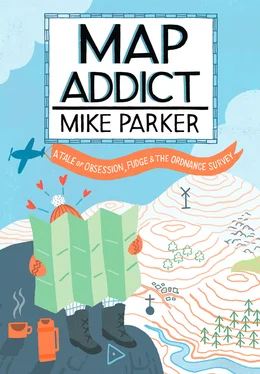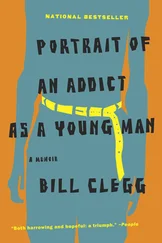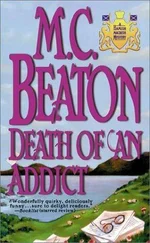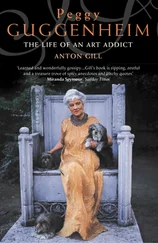Although William Roy died before the official foundation of the Ordnance Survey in 1791, he was its undoubted progenitor. The event that gave formal birth to the organisation was the re-measuring of the Hounslow Heath base line that Roy himself had first established some seven years earlier. In April 1784, following the French submission to George III, Roy had swiftly secured government backing for the survey and wasted no time in getting on with it. He had at his command twelve Army NCOs and an entire division of the 12th Foot Brigade from nearby Windsor; these he set to levelling and clearing the five-mile-plus route of his line. Having a burly crew of soldiers around was also good insurance; Hounslow Heath in the eighteenth century was the most dangerous location in Britain, and certainly not a place for gentlemen to linger. London and Bath were the two wealthiest cities in Georgian England, and the busy road connecting them ran (as it does still) along the heath’s northern edge. The lowlying ground, with its unexpected fogs, suppurating ditches and numerous copses, was the ideal hiding place for highwaymen and cutpurses, who had rich pickings among the well-to-do on their way to Windsor or the West Country. Contemporary maps show a string of gibbets along the Bath Road across the heath. Many of these would have contained rotting corpses swinging in the breeze, for the policy of the authorities was to return the bodies of those hanged at Tyburn to the place of their misdemeanours, to be displayed to all as a shocking deterrent.
Jesse Ramsden—still, at this point, in Roy’s good books—had made a steel chain exactly one hundred feet in length, together with wooden rods of twenty feet apiece: both were used alternately to calibrate the distance as the party progressed slowly from King’s Arbour Field and across the heath, with the distant witch’s hat spire of Banstead church as their guidance point on the horizon. Work progressed through a monumentally wet summer, conditions that didn’t suit the wooden rods, which were found to expand and contract way too much for accurate measurement. The project ground to a brief halt. Glass rods were commissioned and produced, which required the utmost delicacy as they were hauled across the heath, particularly when it came to crossing the busy Staines Road.
Delays occurred too because the surveying team became something of an unlikely attraction, especially after King George III dropped by on 19 July to see how the work was going: unfortunately, so torrential was the rain that Roy was unable to demonstrate much of their work. The King returned on 21 August and spent two hours examining the team’s work and discussing it with them. This, according to Roy, ‘met with his gracious approbation’. In his wake, all manner of society notables trotted by to see what was going on, and it was left to Sir Joseph Banks, the President of the Royal Society, to erect mobile refreshment and hospitality tents in order to cope with the crowds and to keep them at a discreet distance from the work of the surveyors. The team finally reached their destination, the workhouse at Hampton, on the penultimate day of August. By now, the steel chain had been abandoned and the entire measurement had been made using the glass rods. The base line, announced William Roy, was 27,404.72 feet: just over 5.19 miles long. ‘There never has been,’ he declaimed, ‘so great a proportion of the surface of the Earth measured with so much care and accuracy.’
Three years later, when Ramsden’s theodolite was finally ready, the survey continued, using triangulation to work its way from Hampton down to Dover and the English Channel. The supposed aim of establishing the precise relation of the London and Paris observatories was never quite attained, but the process had, in Roy’s eyes, been hugely successful in his main ambition of showing how poor and imprecise current British maps were and how a national survey was both urgently desirable and eminently practicable. In his final report to the Royal Society and the King in 1789, Roy egged them all on:
The trigonometrical operation, so successfully begun, should certainly be continued, and gradually extended over the whole Island. Compared with the greateness of the object, the annual expence to the publick would be a mere trifle not worthy of being mentioned. The honour of the Nation is concerned in having at least as good a map of This as there is of any Other country.
Such as France, Your Majesty, he might have added. It took less than a year for the authorities to agree and to find the money, but, by then, Roy was dead.
The fogs, footpads and gibbets may be long gone from Hounslow Heath, but the land still has a melancholy tang to it, if only thanks to the fact that so much of it has been eaten alive by Heathrow Airport, located there for precisely the same reasons (vast expanse, flat as a pancake, near London) as Roy’s base line. The airport has swallowed whole villages along the northern part of the line, its route south-east has been filled in with shops, factories, houses, roads and all the normal suburban detritus of the outskirts of London. The line, dotted across field and factory, and marked portentously as General Roy’s Base, used to appear on OS maps up until the early twentieth century, though not since. Strangely, the northern end of it at Heathrow is labelled, on the current OS 1:25 000 Explorer map, with the supremely wordy ‘Cannon: West End of General Roy’s Base (site of)’; although the cannon is firmly there in precisely the spot indicated, there is nothing ‘site of’ about it. The other end, at Hampton—which is far easier, and more pleasurable, to find—doesn’t even warrant that, and goes completely unmarked.
Trying to trace the line today, I was reminded of the late Linda Smith’s immortal observation that Greater London was something of a misnomer, for ‘the further you get away from the middle of it, London doesn’t really get greater—it’s more Lesser London’. She came from Erith (‘not so much the city that never sleeps, more the town that lies awake all night staring at the ceiling’), which sits crusted on the rim of the capital in much the same way as Feltham, Bedfont and Hanworth, the sprawls that now cover William Roy’s historic line. There are other invisible lines to contend with here: these undistinguished, indistinguishable towns are firmly on the other side of the tracks from leafy Hampton (as in Court), where Roy’s measurement ended. This lies in that weird little south-western corner of Greater London, the Twickenham-Richmond triangle: smug and tweaked, embarrassed Tory so voting LibDem, death by bungalow and leylandii.
After Major-General Roy conducted his experiments, wooden posts were interred in the ground at either end of the recorded base line as a memorial. In 1791, eleven months after Roy’s death, the party led by the Duke of Richmond, charged with re-measuring the line for the Board of Ordnance, found that the posts were rotting and so they were replaced by upended cannons. There, wondrously, they still remain. Both cannons have seen untold change unfold around them over two centuries. The southern one, at Hampton, witnessed the demolition of the borough workhouse nearby; it thence lived in an area of open ground known as Cannon Field until Twickenham Borough Council built housing estates on it in the late 1940s. At least they left the cannon intact and had the good grace to name the two nearest culde-sacs Roy Grove (where the cannon can be found sat in a grassy gap between two post-war semis) and Cannon Close (which, indeed, it is). This is Hampton as the acme of suburbia, so much so that the street opposite is Acacia Road.
Handily, there’s a bus—the 285 Kingston-on-Thames to Heathrow—that almost precisely connects the two cannons, taking a route that’s only a little over a mile longer than William Roy’s 5.19-mile straight line. The good general wouldn’t recognise it these days. The bus coughs its way up the Uxbridge Road and into Feltham, doing a quick detour into the Sainsbury’s car park, and passing forlorn-looking light industrial estates, the Clipper Cutz hair salon, the Chirpy Chaps barbers, Cindy’s Nail Bar, Fryday’s chippy, a Subway or two, the A3 roundabout and parades of Metroland semis displaying either a St George’s flag or a ‘No To Heathrow Expansion’ sticker, sometimes both (albeit quite hard to see through the triple glazing).
Читать дальше












